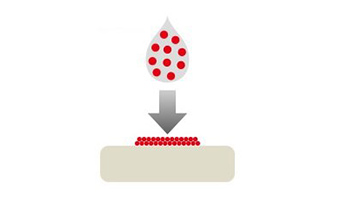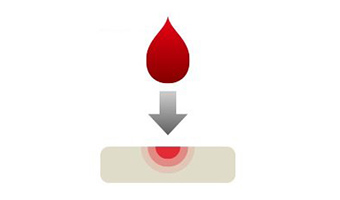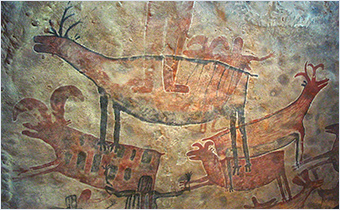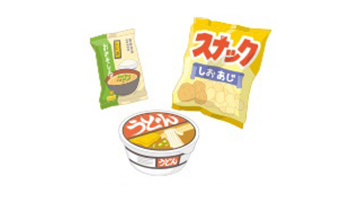What is pigments?
- Types of coloring materials (dyes and pigments)
- Types and properties of pigments
- History of pigments
- pigments notation
- pigments uses
- Our organic pigments
Types of coloring materials (dyes and pigments)
There are many things around us that have beautiful colors. In addition to naturally occurring plants and animals, man-made objects such as brightly colored cloth, paper, vessels, and buildings add beauty to our lives. Coloring materials are used to color these artificial objects.
Coloring materials literally refer to ``raw materials for color'' and can be broadly divided into ``dyes'' and `` pigments.'' Both are colored powders, but dyes dissolve in water or oil and have the property of penetrating between the fibers of cloth, paper, etc. to dye them. On the other hand, pigments have a major difference in properties: they do not dissolve in water or oil, and can be colored by adding a binder (fixing agent) to the surface.

Pigment
The pigment settles on the surface of the paper and colors it.

dye
The dye soaks into the paper and colors it.
Types and properties of pigments

Natural minerals pigments are literally pigments obtained from naturally occurring minerals and soil. Typical examples include ochre, peacock stone, and turquoise, which are still used today as rock paints in Japanese painting.
On the other hand, synthetic inorganic pigments are made from oxides and bonds obtained by chemical reactions of metals such as iron, copper, and lead. Typical examples include cobalt blue, lead yellow, and titanium white, which were discovered, manufactured, and used mainly between the 18th and early 20th centuries. Various other "special pigments" materials have also been developed, including fluorescent pigments materials that glow brightly in the dark, like neon signs.
| classification | inorganic pigments | Organic pigments | special pigments | |
|---|---|---|---|---|
| natural mineral pigments | synthetic inorganic pigments | |||
| Type | red clay ocher green soil malachite gofun graphite |
dark blue zinc oxide cobalt blue emerald green Billijan titanium white |
alkaline blue lysol red Carmine 6B Disazo yellow phthalocyanine blue quinacridone red isoindoline yellow |
fluorescent pigments metal powder pigments pearl pigments thermochromic pigments pigments |
| nature | Calm color tone Few colors relatively cheap High specific gravity (heavy) Excellent weather resistance |
vibrant colors There are many colors Some are expensive Low specific gravity (light) Excellent coloring power |
* Varies by type | |
History of pigments

Most of the animal murals are painted in brown or black. This is due to the use of natural mineral pigments such as red clay and black clay, which were readily available and available, and it is thought that these clays were mixed with animal fat and painted on the walls of the cave. Since then, humans have continued to discover new natural mineral pigments (colored rocks and soil) and use them as coloring materials.
Natural mineral pigments are naturally formed on Earth over hundreds of millions of years. Therefore, it is resistant to discoloration even in open environments, and has excellent light and heat resistance. However, on the other hand, the particles are hard and coarse, and the coloring power is limited, so it has the disadvantage that sufficient coloring cannot be obtained unless it is applied over and over again.
Also, the most inconvenient thing is that since it is a natural product, the amount that can be harvested is limited. Some pigments, such as ultramarine (blue) made from a gemstone called lapis lazuli, were so valuable that they rivaled gold, and painters in the Middle Ages had to serve the royal court to receive pigments. Without it, it is said that painting would not have come true.

In the 19th century, organic pigments made by combining dyes and metals appeared. Organic pigments have many advantages over inorganic pigments, such as vivid colors, strong tinting power, and a wide variety of colors. In addition, in recent years it has been discovered that some inorganic pigments are toxic, so organic pigments that are harmless to the human body are becoming increasingly important.
pigments notation
Color Index Generic Name is a method used internationally to identify individual pigments. The color index name is a notation method for pigments registered in "CI (Colour Index International)" (a database jointly maintained by the British Institute of Dyeing and Dyeing and the American Textile Chemistry and Dyeing Technology Association).
C.I contains color index names based on utility and color for more than 6,000 dyes and colorants (pigments and dyes) and related compounds. In addition, each of them is given a "Colour Index Constitution Number", and their product name, chemical properties, manufacturing method, etc. are also listed.
On the other hand, pigments can also be identified by their "CAS number." CAS is an abbreviation for "Chemical Abstracts Service" and is a compound number used in the "Chemical Abstracts" magazine published by the American Chemical Society. A CAS number is a number of up to 10 digits that can be used to identify chemicals, including pigments.
| chemical structure name | Copper phthalocyanine (phthalocyanine blue) |
|---|---|
| color index | Pigment Blue 15 |
| CIConstitution No. | 74160 |
| CAS number | 147-14-8 |
pigments uses
pigments is used in a variety of applications, from coloring various printing inks, paints and plastics to cosmetics, textiles, and food. Its use varies greatly depending on the nature of the pigments. For example, inorganic pigments, which has excellent weather resistance (* resistance to light, wind and rain, and temperature changes) and is relatively inexpensive, is often used in coatings for products that have a large coating area and are left outdoors for long periods of time, such as construction materials and containers. On the other hand, about 60% printing inks of organic pigments, which has excellent coloring power and vivid coloring, is used as a colorant for plastic products, and about 20% is used as a colorant for plastic products.
In addition, some pigments are used not only for coloring, but also for special purposes. For example, "constitution pigments" (white and colorless pigments used as a * extender) is used in cosmetics face powders because of its glossy and high adhesion. In addition, carbon black, which is black pigments, is used in tire products such as automobiles because its strength is significantly improved when kneaded into rubber, and it is also used in electronic components and magnetic tape materials by taking advantage of its conductive properties.

Automotive

food packaging

Art supplies such as crayons
Our organic pigments
TOYOCOLOR 's organic pigments are used in a variety of applications that require color, including printing inks, paints, and plastic coloring, as well as color filter for LCD displays, toner for color copiers, and inkjet inks. In addition to hues and dispersibility suitable for a wide variety of uses, we support colorful lifestyles with a wide variety of products that have added features such as weather resistance, heat resistance, and safety depending on the manufacturing process and application of the product. doing.
Inquiries
TOYOCOLOR CO., LTD. Coloring Materials Sales Department
TEL: +81-3-3272-0818
